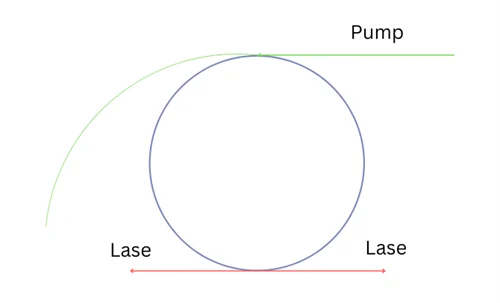First Chip-Scale Titanium-Doped Sapphire Laser
By Ilamaran SivarajahFeb 24 2023
The first chip-scale titanium-doped sapphire laser has been developed by a research team at Yale University. Led by Professor Hong Tan, this experimental breakthrough could pave the way for new innovations in atomic clocks, quantum technology and spectroscopy based research endeavors.
Titanium sapphire (Ti:Sa) lasers have been widely used in chemistry, physics, and biology since their introduction in 1982. Commercial Ti:Sa systems offer wavelength tuning of around 450 nm from red to near-IR with narrow linewidths. Lasing from around 650 nm to 1100 nm is achieved by utilizing a single crystal. Ti:Sa crystal is also capable of producing mode-locked pulses with femtosecond pulse-widths thanks to its broadband gain.
Ti:Sa lasers produce low noise radiation with beams that have high mode quality. These features are beneficial for the emerging quantum technology industry to address photonic qubits and atomic quantum platforms.
Disadvantages of Free-Space Ti:Sa Lasers
Ti:Sa lasers stand apart from other laser technologies like semiconductor lasers, laser diodes and gas lasers thanks to the special characteristics of the gain medium. However, commercially manufactured Ti:Sa lasers are expensive and complicated systems that include a reference locking cavity, complex laser cavity designs, and high maintenance pump excitation laser, all of which are made of large free-space components. The Ti:Sa laser threshold is also higher than that of other lasers because of the brief lifetime of excited states of the gain medium, the low concentration of ions that fluoresce, and the normal residue absorption during crystal formation.
Research Efforts to Make Compact Ti:Sa Lasers
There have been several research efforts to make Ti:Sa laser systems compact. Ti:Sa microfibers, Whispering Gallery crystals, and thin films created by thermal diffusion and pulsed laser deposition have all been used to reduce the size of Ti:Sa lasers. The optical mode, however, has been a challenge to control efficiently because of the low index disparity and optical confinement. As a result, substantial radiation losses obstruct the creation of small photonic integrated circuits for operating Ti:Sa lasers.
Chip-Scale Ti:Sa Laser
The research team at Yale University has shown the first chip-scale Ti:Sa laser that spans the full spectrum offered by the Ti:Sa crystal and record-low threshold passive photonic circuits (PIC). The emission signals are produced from an output waveguide by integration of Ti:Sa lasing medium directly on a silicon nitride photonic platform. A wavelength range covering the near IR spectrum from 700 nm to 950 nm has been demonstrated.
The Ti:Sa cavity, associated pump laser, and external locking cavity could all be integrated on a single chip in the sapphire-based PIC systems. The heterogeneous integration technique offers new implementations for the generation of atom driven photonic systems by being integrated with different solid-state gain mediums.
Because of their short lifetime, low emission cross-sections, and low ion doping concentration, Ti:Sa lasers have low gain and necessitate a large pump power. The majority of Ti:Sa lasers operating in free space have modes larger than 200 square microns and a pump power threshold of up to 1 watt. The mode size is reduced to less than one square micron by the integrated photonic platform due to the strong confinement factor, resulting in a threshold power below 10 mW.

Figure 1: Illustration of the Ti:Sa microring device showing the Ti:Sa gain, the pump light that is connected through the waveguide and lasing in the red to IR wavelength range
A traditional free-space Ti:Sa laser must have the power within the cavity to build up to greater than 300mW in order to achieve 0.2 dB/cm gain. Alternatively, an on-chip laser requires only tens of milliwatts of power to establish an optical enhancement of 0.4 dB/cm. The pump microcavity enhancement significantly lowers the threshold because the pump mode is simultaneously in resonance with the lasing mode.
The chip-scale integrated laser method has a higher photoluminescence efficiency thanks to the simultaneous resonance of a micro-ring resonator at both lasing and pumping wavelengths. To excite the Ti:Sa gain, the pump light is connected through the waveguide that surrounds it as depicted in figure 1. By adjusting the chip temperature, resonance conditions for the pump are maintained. Lasing mode is connected to the output waveguide port and is also in resonance.
The researchers at led have succeeded in on-chip lasing from a Ti:Sa in the 730–830 nm range. The linewidth of the laser was determined to be 120 kHz by comparing the heterogeneously integrated laser to a reference laser.
Future Outlook
The new developments from the research team at Yale led by Prof. Tan has demonstrated milliwatt-level lasing threshold for a Ti:Sa laser system that is chip-integrated with a broad emission spectrum. The Ti:Sa integration is expected to eventually result in more chip-scale capabilities, opening the door for on-chip atomic clocks, quantum metrology, AR/VR gear, and optical communication systems. The adaptability of the heterogeneous integration technique enables the integration of additional waveguide platforms into the photonic toolbox to increase the on-chip laser's emission spectrum, including lithium niobate, aluminum nitride, and other gain media.
Written by
Ilamaran Sivarajah
Ilamaran Sivarajah is an experimental atomic/molecular/optical physicist by training who works at the interface of quantum technology and business development.
